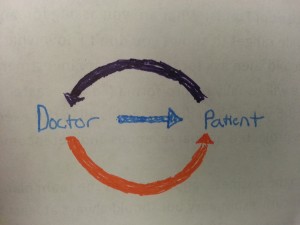A lot of the discussion that we have in class is based around e-patients. In fact, one of the groups even has the direct problem of figuring out how to create more e-patients. So I find that I spend a lot of time thinking about this subject.
During this process, I seem to have come to the conclusion that a majority of the work surrounding e-patients has been directed at the patient end of the doctor patient spectrum. That makes sense right? We want “engaged” patients so we focus on giving these patients the access they need to knowledge and resources to understand and improve their health. So when we look to “create” more e-patients we focus on the patients. Sounds reasonable.
But we’ve become so focused on the patient that I can’t help feeling like there is a strategy we’re overlooking.
The picture below is of a model of patient-doctor communication that we looked at in class. When we look at creating e-patients we think of starting at the purple arrow: where engaged patients engage their doctors who then reciprocate.
But what if we started at the orange arrow?
I think there is probably a large proportion of patients that are very accustomed to the traditional model of patient-doctor communication. Why don’t we use that to our advantage? If doctors used their influence to encourage patients to start doing some of the activities associated with e-patients and gave them the resources, patients may be more motivated and feel more comfortable becoming e-patients.
All doctors have to do is get a patient started; once that happens, I think the nature of the e-patient community will automatically encourage a patient to take more responsibility for their health.
That’s why think there needs to be a segment of the e-patient movement that is focused primarily on convincing doctors to encourage their patients; a group focused on teaching doctors the value of e-patients.
Maybe that already exists. Or maybe I’m wrong. Maybe this is too controversial. I know e-patients sometimes pride themselves of being autonomous and not needing a doctor to tell them what to do.
But if this can help us create more e-patients, isn’t that a goal we all share? It’s definitely something worth thinking about.

